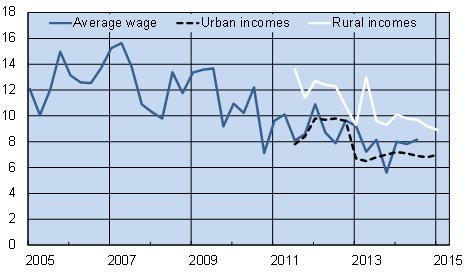BOFIT Weekly Review 19/2015
Chinese wage growth remains robust
Even with the overall slowdown in Chinese economy, wage growth has slowed only modestly. Factors supporting real wage growth, in addition to economic growth itself, include China’s shrinking labour supply and low inflation.
The latest official figures show the average monthly wage in the third quarter of 2014 was 4,460 yuan (€550 at the time or €640 at the current exchange rate). The average nominal wage showed a gain of 10 % y-o-y and the real wage 8 %. Nevertheless, differences across sectors and provinces are large. Average wages in Beijing and Shanghai were 80 % higher than the national average. Wage levels were below average in most interior provinces.
A second wage divide can be seen between the countryside and cities. The latest China Household Finance Survey found that the average monthly wage in rural areas was less than 1,100 yuan (€160) in January-March, while the average wage in urban areas exceeded 2,850 yuan (€400). The National Bureau of Statistics put the average monthly wage of China’s more than 160 million internal migrant workers at around 3,000 yuan (€430) for the first quarter.
In dollar terms, Chinese labour costs are perhaps already on par with Malaysia and Thailand, and several times higher than in their poorer Asian counterparts. The growth of China’s domestic markets and the shift of production to cheaper interior provinces still attract production investment to China, but labour-intensive export industries are now looking elsewhere.
Real growth in average wages and disposable incomes, %

Sources: Macrobond, BOFIT